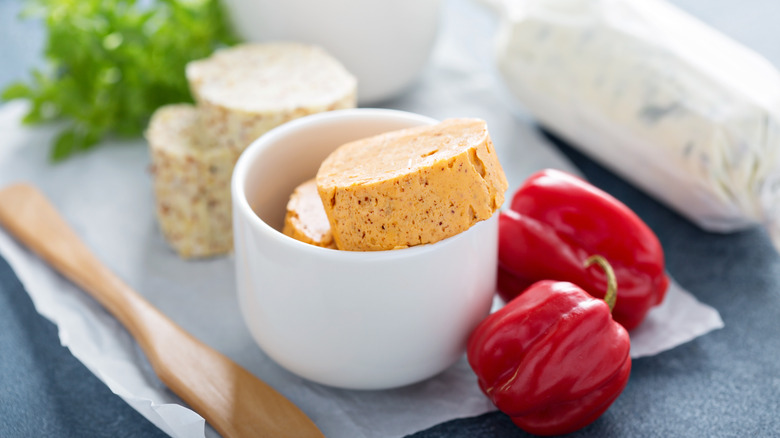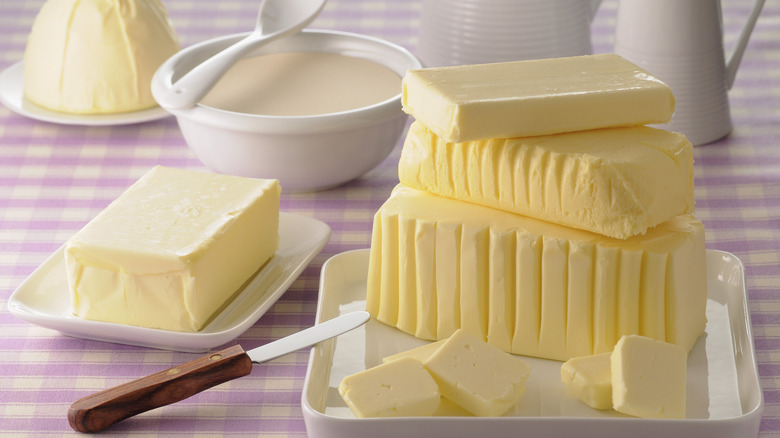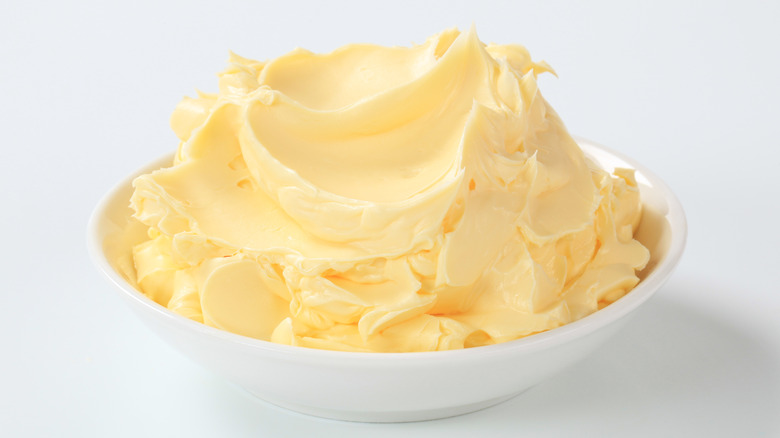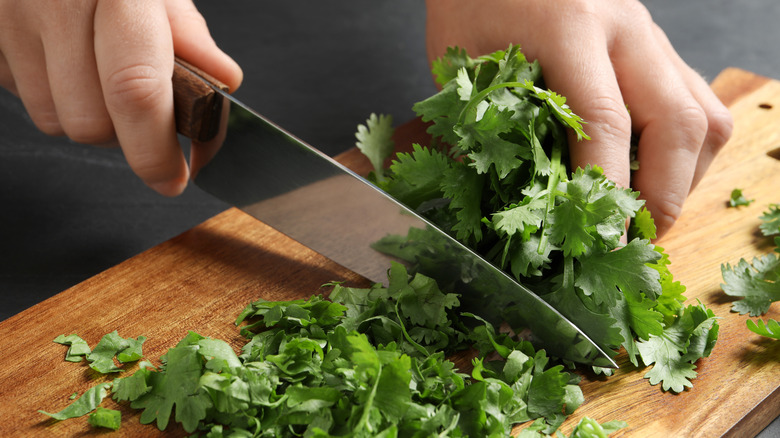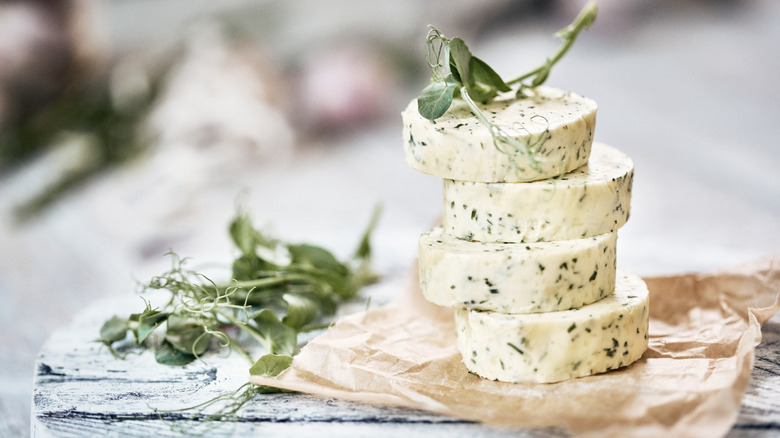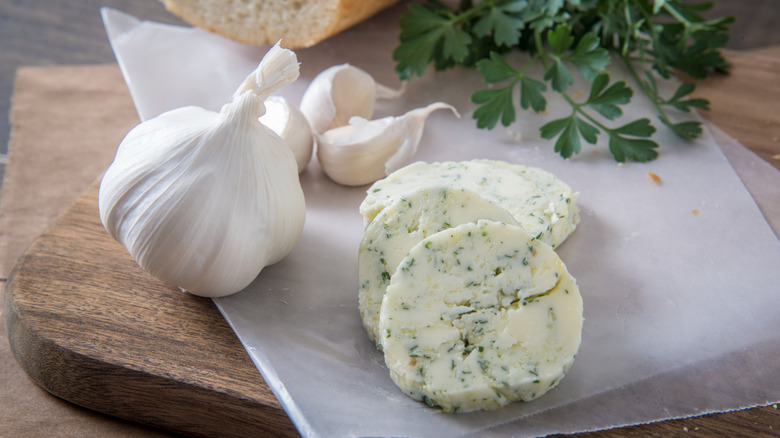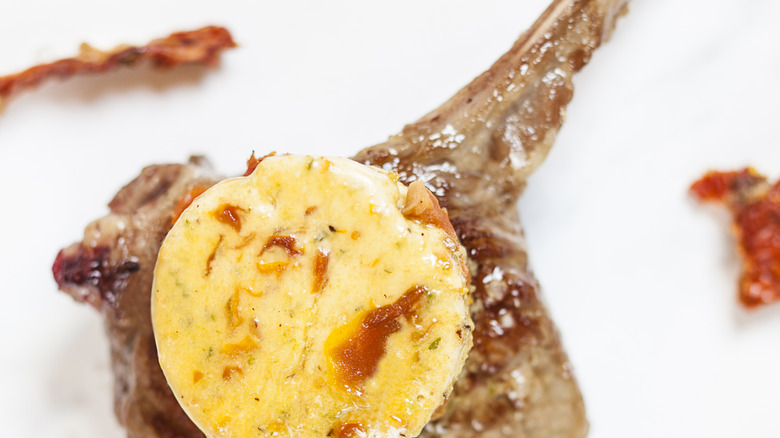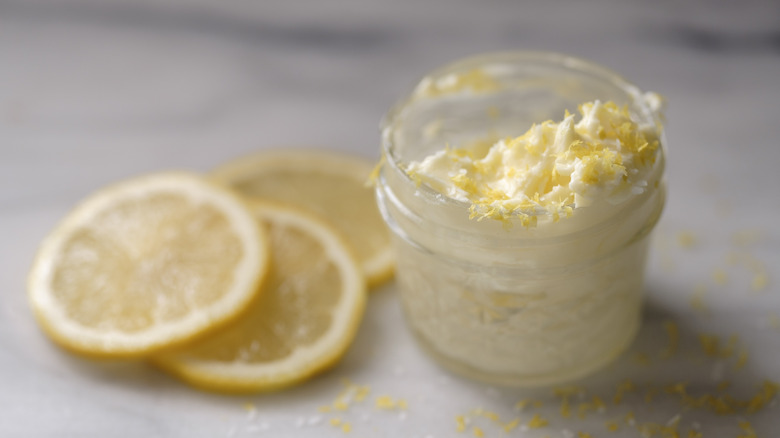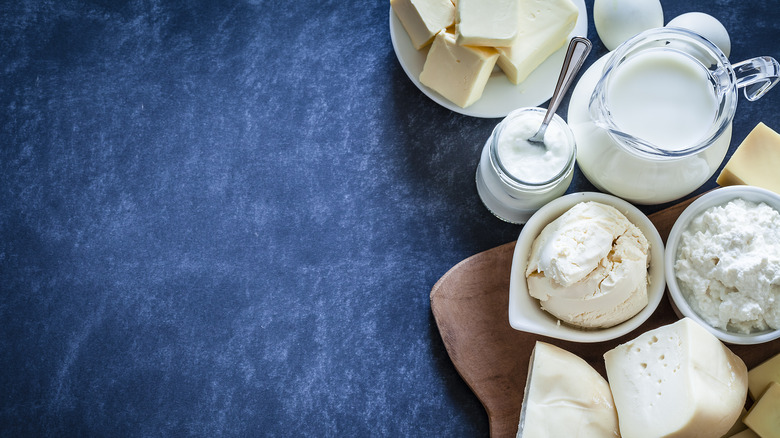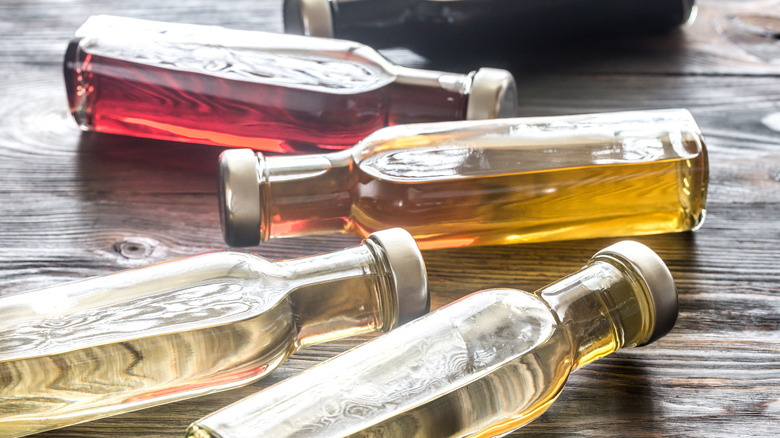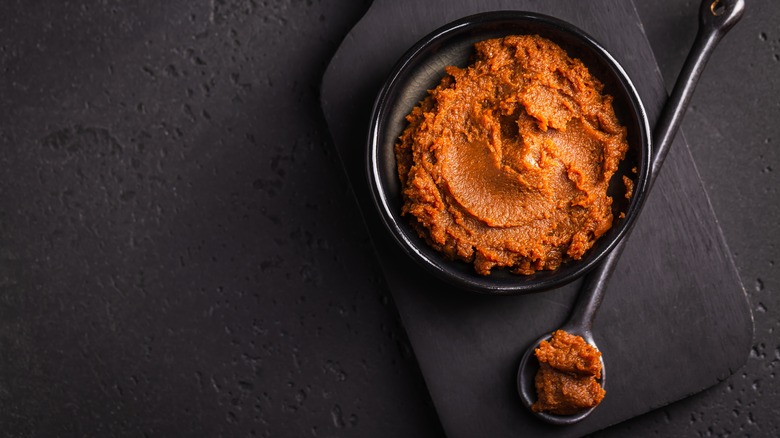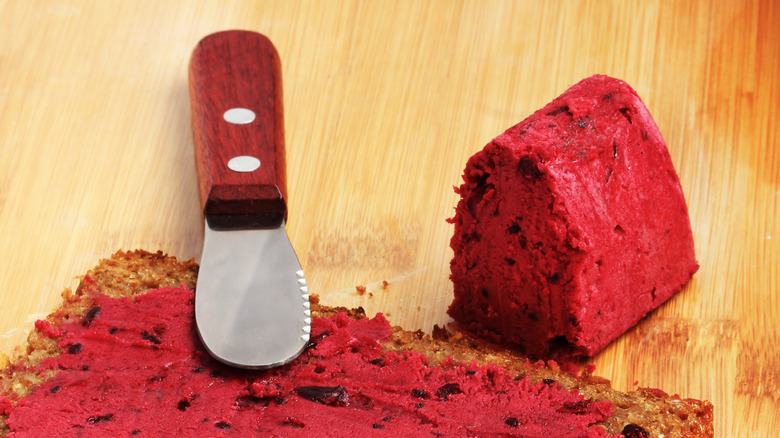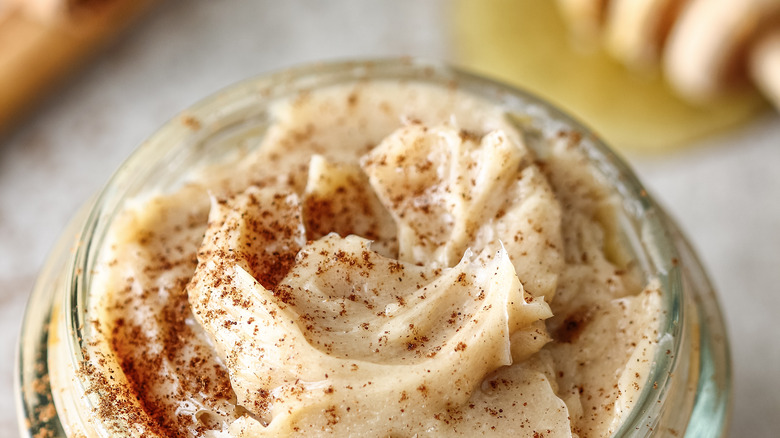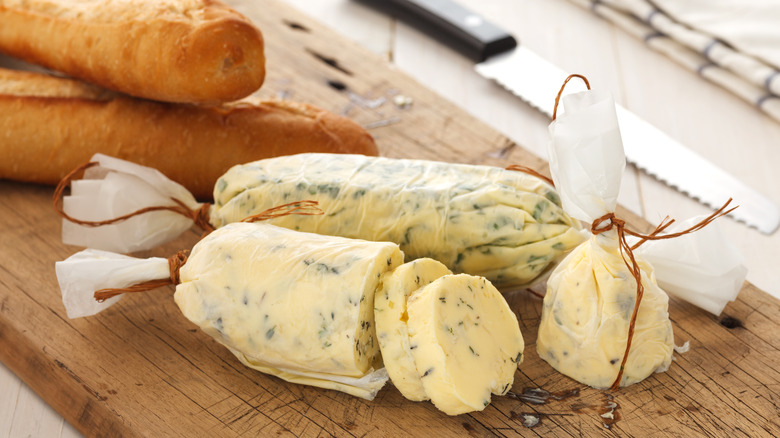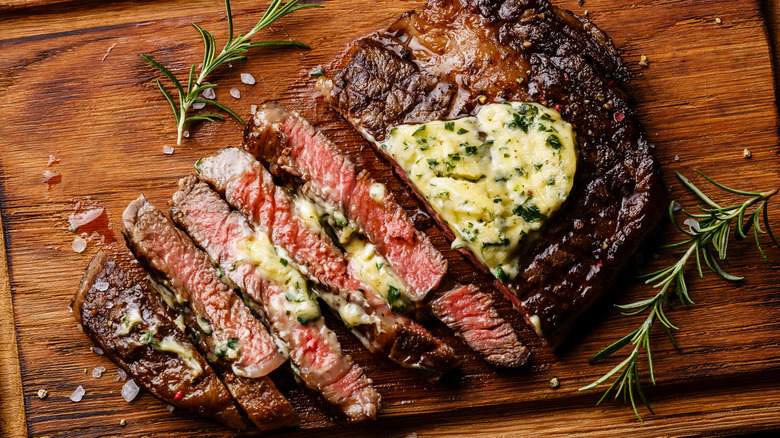14 Tips You Need When Making Compound Butter
Compound butter — or "beurre compose" — is a French creation that exemplifies the central role of butter in French cuisine. It's a simple but powerful combination of plain butter and other components that form a richly flavored buttery spread. Compound butter is used in the same way as regular butter. It can function as both a cooking ingredient and as a topping to add a finishing touch to your food. Additionally, it can be used to enrich sauces, sautee vegetables, baste meats, flavor pastries, and more. Compound butter has an advantage over other types of butter because it can be used to layer increased flavor and complexity.
The flavorings can vary and may include herbs, spices, fruits, vegetables, and other seasonings. The resulting compound butter may be sweet or savory, spicy or mild, bold or delicate. Compound butter is a simple and effective way to elevate a dish and infuse an extra layer of flavor during cooking, or to enliven a dish at the very end. Butter makes everything better, and compounding makes butter better.
1. Choose the right butter
Compound butter influences the overall flavor of any dish it's used in, so the starting flavor of the butter is crucial. Choose a high-quality butter made from top-notch ingredients. The diet of the animal, churning technique, and final fat content all influence a butter's flavor, so opt for one you enjoy the taste of on its own. Compound butter isn't used to disguise the flavor of subpar butter, but rather to amplify the taste of the butter and the additives together.
It's also important to make sure your butter is very fresh. Butter's flavor is strongly impacted by its exposure to air over time so the fresher, the better. Additionally, foil packaging better protects butter from deterioration and flavor absorption. For the best flavor quality, select butter sold in foil rather than paper when possible. No matter what brand of butter you choose, make sure to start with unsalted butter so you can better control the flavor during preparation.
2. Whip it good
The first step in preparing compound butter is bringing your butter up to the correct temperature so that it's softened but not melted. It should be warm enough to mix easily and allow the flavorings to combine with the butter's oils, but not so warm that it separates or becomes liquid — ideally 60 to 68 degrees Fahrenheit (room temperature). The most reliable method is to remove the butter from the fridge and leave it on the counter until it softens. This way, it can reach room temperature gradually and there's less danger of melting. It takes between 30 and 60 minutes to properly soften the butter this way. If you're in a hurry, cutting the cold butter into small cubes or even grating it coarsely with a cheese grater can help your butter soften more quickly. You'll know the butter is correctly softened when you can press into it easily but there's still a bit of resistance.
Once your butter is ready, use a fork or pastry cutter to begin mixing it. This is the simplest method and will achieve fantastic flavors once you add your mix-ins, but for an even lighter and airier compound butter, use a hand mixer to whip the butter until it's light and fluffy. If you don't have an electric mixer, you can also whip your butter by hand using a fork in a circular whipping motion similar to scrambling eggs.
3. Prep your add-ins
Choose what flavorings you'd like to add and get them all measured, chopped, and ready to go before you begin mixing anything in. Using somewhere between 2 and 5 tablespoons of mix-ins for a 4-ounce stick of butter is a good rule of thumb, depending on what you're adding.
How you prep your ingredients will depend on what type of compound butter you're making, but there are a few general guidelines to keep in mind. Chop or zest any plant materials such as herbs, garlic, fruits, or vegetables very finely. When using cheese, shred it as small as you can, or even consider grating it into a powder. Cutting the add-ins into small pieces allows for the maximum release of their flavors and will also create a more consistent texture in the finished butter — no noticeable chunks and lumps.
It's also important to remove excess moisture from your supplementary materials so the finished compound butter doesn't end up watery. With this in mind, thoroughly dry any produce, squeeze out chopped fresh herbs, and create reductions from liquids before adding them in.
Once your ingredients and butter are prepped, simply add the chosen flavorings and mix them until they're well combined. It's as simple as that!
4. Mix in fresh herbs
Herbs make an excellent ingredient for compound butter. In fact, the original compound butter, Beurre Maître d'Hôtel, is a mixture of butter, parsley, and lemon juice prepared at tables in French restaurants, according to The San Diego Union-Tribune. It's a classic combination that demonstrates how butter plus herbs consistently just works.
Parsley is a great starting point, but herb compound butter can incorporate rosemary, basil, oregano, thyme, dill, cilantro, sage — essentially any herbs you enjoy. Herb butters often include a small amount of lemon juice to brighten and lift the flavors and salt and pepper according to personal taste.
Dried herbs generally aren't used for compound butter because the act of chopping and bruising fresh herbs releases their aromas and flavor compounds more fully. Fresh herbs are also softer, so they seamlessly mix into the butter without degrading its smooth texture. As with any ingredients, chop your herbs very fine, remove excess moisture, and mix until thoroughly combined.
5. Use alliums such as garlic, shallots, and chives
Compound butter made with alliums, like garlic, is almost as classic and popular as herb compound butter. Butter softens the sharp pungence of garlic and other alliums to allow the subtler nutty and spicy flavors of these plants to shine through.
Garlic butter is often spotted slathered on pre-made garlic bread in a grocery store or bakery aisle, but it's very simple to make at home. As with herb butter, it's best to use fresh produce rather than dried or powdered ingredients. Again, you'll want to finely mince everything before adding it and salt the butter to taste. Raw, fresh garlic, shallots, and chives all make an outstanding compound butter, particularly when combined with parsley. For a mild, sweet, and complex option, try using cooked alliums. You could use roasted garlic, caramelized onions, or fermented black garlic for an earthy-sweet compound butter that goes way beyond a bread topping. Use it atop steaks or seafood, as a base for sautees, in sauce, or to baste a roast chicken.
6. Include a bit of fiery spice
For compound butter with a spicy kick, incorporate fiery hot ingredients as your add-ins. The dairy fats in the butter temper the heat slightly, while also bringing out the less painful flavor components of peppers, spices, or curries. Finely minced fresh raw peppers such as ancho peppers, chipotles, or jalapenos add vibrant smokiness and a mild heat level to compound butter. For the truly bold, habanero peppers add a berry sweetness along with face-melting heat. These various pepper-infused compound butters make excellent accompaniments for vegetable and meat dishes.
You can also produce a pleasantly burning compound butter with piquant dried spice mixtures from around the world. Use fragrant Korean gochugaru spice paste in a Korean barbecue compound butter or gochujang paste for a slightly sweeter twist. Try adding Thai red curry paste, or use your favorite curry powder. You can even take curry butter in a sweeter direction with honey-curry compound butter, or go the homemade route and make your own spice blend to use in cowboy butter. Experiment with jerk spices, za'atar, or harissa; use any spice combination that matches the flavor of your finished dish or cuisine you regularly cook.
7. Get zesty with it
Herb and garlic butters frequently include lemon, but when it comes to compound butter, you have more options. A variety of citrus flavors marry well with other tastes in compound butter, as their acidity cuts the fatty richness of the butter and lightens the flavors with an extra zing. Use citrus zest rather than juice since zested rind packs more flavor and less water content. Lemon or lime-zested compound butter is a natural fit with any seafood dish and also perks up sauteed and grilled vegetables in the spring or summertime — particularly radishes, asparagus, snap peas, and corn.
Citrus zest compound butter can also be used on sweet foods. For example, orange butter elevates breakfast or dessert when it's melted onto pastries, pound cake, pancakes, waffles, or other sweet baked goods. Blood orange, grapefruit, and yuzu zest all work similarly well in compound butter for sweet or savory applications.
8. Add cheese to the mix
Adding cheese to compound butter imparts an earthy complexity and robust flavor explosion that only aged cheeses can provide. The balance of a developed cheese against the mellow fresh butter flavors creates a compound butter that's incredibly creamy and refined.
For cheese compound butter, choose a strongly flavored cheese like Parmesan, gorgonzola, cheddar, brie, or bleu cheese. These work better than mild fresh cheeses like mozzarella, which can be overpowered by the butter. When working with a semi-hard cheese like cheddar, shred it as finely as you can, or with bleu cheese, crumble it into small chunks. If you're using parmesan, grate it into a powder. For softer cheeses like brie and soft bleu cheese, slice them into small cubes and allow the cheese to soften before mixing it in.
You can take your cheese compound butter a step further by using cheese in combination with other additives. For example, combine paprika with cheddar, bleu cheese with pear, or Parmesan with garlic.
9. Include wine or vinegar reductions
Similar to citrus zest, the natural acidity in wine and vinegar cuts the oil of the butter and lightens up the overall flavor profile. Wine and vinegar also impart their own mature subtleties based on the grape variety, growing conditions, fermentation, and aging process. Using wine in a compound butter is a shortcut to incredibly nuanced cuisine.
Butter amplifies desirable qualities in red wine and port wine in particular, but white wine can be an excellent option as well. Balsamic vinegar is one of the best options for vinegar to add to compound butter due to its delicate balance of sweetness and tanginess. Red wine vinegar and champagne vinegar also work wonders. Or, avoid grapes entirely and opt for apple cider vinegar, or a boozy compound butter with gin or bourbon. Again, the existing complexity in the alcohol adds astonishing flavor to the completed compound butter.
Ideally, these liquids are boiled down into a reduction before being added so the water content isn't too high in the finished butter. Alternatively, you can soak minced shallots, onions, or other solid ingredients in the alcohol or vinegar to let them absorb some of the liquid and its flavors, rather than attempting to mix the liquid directly into the butter.
10. Provide a boost of umami
Falling somewhere around "savory" or "meaty," umami is that untranslatable, indescribable, and extremely crave-able flavor that makes foods ultra delicious. Give your compound butter a boost of it by using an umami-rich ingredient like miso paste, Worcestershire sauce, sal de gusano, chopped anchovies, or anchovy paste.
Many of these ingredients come conveniently in paste or dried forms already, but if they're not, chop the ingredients very finely and reduce moisture in them as much as possible. Since umami bombs like anchovy paste are very strong, it doesn't take much to have a big impact. With this in mind, adjust your ratios to include less of these ingredients than you would when using vegetables, herbs, or other flavorings. The umami shouldn't overpower the butter. Rather, they should complement each other so that both are still discernable in the final product. Compound butter enhanced with umami-forward ingredients is best paired with savory dishes.
11. Incorporate fruit or fruit preserves
Fruit and fruit preserves offer a sweet option for compound butter. Fruit preserves work well because the fruit is already cooked and therefore softened, they come already sweetened, and fruit in jams and jellies is already chopped into small pieces, so it's easy to mix in. However, fresh fruit can be effective as well, provided the fruits are chopped very small and the pulp is wrung out to remove excess moisture. Raw fresh fruit may need an additional sweetener like honey to enhance the fruit's natural sugars. Fruit and fruit preserves also add a lively burst of color to the butter for an attractive presentation.
Almost any fruit will work in compound butter, but blueberries, strawberries, and blackberries are especially appealing. Apricots are a great option as well since their tartness evens out the sugary fruit flavors. Fruit compound butters are best when served with sweet dishes such as baked goods, pastries, and breakfast breads.
12. Try baking spices
Honey butter and cinnamon butter are well-known types of sweet compound butter often used on biscuits and other bread products. There are many possible variations, but they typically include the same baking spices used in pies and sweets. To make your own cinnamon butter, incorporate dried cinnamon powder, ginger, cardamom, cloves, vanilla bean paste, or a combination of any of these. Although we associate them with bakery sweets, baking spices alone aren't inherently sugary, so you'll need to add a small quantity of brown sugar or honey to the compound butter to sweeten the spices and enhance the sweetness of the cream.
This variety of compound butter makes a decadent topping for French toast, pancakes, waffles, or any sweet bread product. It can also be used as a baking ingredient and incorporated into bread, pastries, or desserts during the cooking process.
13. After mixing, shape and rechill
After you've mixed your desired flavor combinations into the butter, mix it thoroughly so the ingredients are well incorporated and the texture is consistent throughout. You're looking for a finished product that looks fairly homogenous and doesn't have large chunks or any areas without flavoring.
Next, shape the completed butter into a log and squeeze out the air. Wrap the log with plastic wrap, wax paper, or parchment paper, and twist the ends to seal. For a pretty visual flourish, you can tie the ends with decorative twine. Chill the finished compound butter in the fridge so it returns to a firm consistency. Once it's chilled, it's ready to use.
When properly sealed, compound butter can keep for up to a month in the refrigerator, depending on the add-ins used and the date on the original butter. If you need to preserve it for longer, you can slice it into smaller portions and freeze the individual rounds. Compound butter can be kept for several months in the freezer.
14. Slice and serve
Once your compound butter is finished, slice it into rounds for serving. Some people like to top the rounds with a little finishing salt for added crunch and flavor. The possibilities for how you can serve and use a compound butter are almost infinite.
For starters, you can use it just as you would plain butter. Slather it on a slice of crusty baguette or corn on the cob, or melt it onto a baked potato. Dress roasted vegetables with compound butter, or use it to sautee anything: seafood, vegetables, meat, or poultry. Rub herb butter under the skin of chicken or turkey prior to roasting. Make butter-basted eggs or steaks using flavored compound butter in lieu of regular butter. Add it to a pan after cooking a main course and scrape up any browned bits to make a no-fuss pan sauce. Or use it as a topping for grilled steak or seafood. Anywhere you use butter, you can use compound butter instead.
